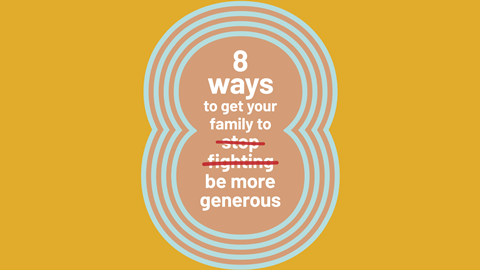Forming faith rituals

I wish I could tell you how to stop your children fighting. There’s probably something good about children developing social skills in the home and feeling safe, and not restraining their behaviour to please others. But honestly, less fighting and arguing in our home would be quite nice!
However, I do have an idea. When it comes to aiming to reduce a behaviour (for myself or my children) I tend to prefer positive motivation rather than punishment. When I need to drink less coffee, I aim to drink more water. When I need to stop scrolling at night and go to sleep, I put my alarm on to wake up earlier. And for fighting, this means I actively encourage a positive behaviour. Focusing on the positive is probably partly a personality thing for me, but I reckon it works, especially as it gives us a chance to celebrate good things done rather than bad things not done.
What’s the opposite of fighting? Well, you can probably come up with a list, but for me I’d go for kindness, peace and generosity. Fighting in my home usually comes from us thinking about ourselves rather than others, so any positive way of framing being nice to each other works as an opposing force!
But how can we get our families to be more generous? Here are some ideas:

1. Model it
As with anything we want our children to do, the best way is to do it ourselves. Asking them to tidy their room when ours is a mess is a big ask! Over the many years we spend living with our parents, we unconsciously and automatically adopt their way of doing many things, unless we purposefully choose to do otherwise. Ask your friends who bake cakes or garden or read a lot or climb mountains if their parents did. And it’s not just the things we do, but the way we do them.
I remember doing my first independent supermarket shop as a teenager and getting funny looks from the cashier when I put a tin in one bag, potatoes in another, pizza in another and then soy sauce in the first bag. I was organising the shopping into where it would be stored when I go home (cupboard, fridge, freezer) – a system I had unconsciously adopted from being with my mum when she did it.
There’s also something about having someone else being generous to us which makes us more likely to be generous to others. It’s that whole pay-it-forward thing.
So, if you want your children to be more generous, be more generous!

2. Invite them to join in
In the Parenting for Faith material, one of the five key tools is ‘creating windows’. This means doing faith in such a way that your children can see it. This sometimes takes a bit of organising and changing routines on our part, as we can often do faith activities during times we’re not with our children. But children need to see us being generous and also to be invited to join in.
You can include your children in your financial giving when they’re young by giving them cash to give to a charity collection or on a plate at church as well getting them to press ‘send’ when you’re giving online, maybe to a friend running the marathon for charity. We can involve older children in our discussions about which places to give money to or spend time volunteering together. Just including the word generous in discussions about why and how we want to do something positive in the world helps to frame it in a way they can understand.

3. Read stories about it
As Christians, we can read Bible stories about generosity – you won’t find many by searching on that term, but the concept of generosity is evident throughout the Bible: the widow’s mite or the feeding of the 5,000. If you’d like a fun sticker-based way to explore twelve Bible stories on generosity, you should get the sticker book Exploring Generosity with GodVenture and 40acts.
But there’s more – we can read books about people who are generous: fiction books and biographies are great places to look for this.

4. Chat about it
Including generosity in our conversations just gives it more airtime and thus we are more likely to see opportunities to be generous. In our family, we love to chat about stories, and generosity doesn’t have to be the ‘main theme’ of the book. You can simply ask open-ended questions about any story: Where in this story was someone generous? What was the most generous thing someone did in this story? Who need people to be generous to them? This also works for films and TV programmes.

5. Make it easy
This is oh-so important! Let’s make things easy, accessible and simple. Start small – what one thing could you do right now to be generous? Could you send someone a text to see how they’re doing? Clear the dishwasher even though it’s not your turn? Keeping it simple and easy means we can do it. It’s not a huge hurdle or something we need a planning day or a spreadsheet to execute. Just do simple things which are kind and loving and generous and you’ll change your world!

6. Keep it varied
Generosity isn’t just about money. We can be generous with our words, our time, our belongings, our home, our garden, our parking ticket! Get creative and see how many different ways you can be generous! If you’re stuck for ideas, you will like this giant Generosity Challenge poster with 40 ideas (and stickers to add when you’ve done one).

7. Do it often
One of the great things about keeping it simple and being generous in a whole variety of different ways is that you can do it more often. Daily is good, which is why the Generosity Challenge is a good idea. But even if you just count how many times you do something generous this week, you’ve then got a baseline to increase it next week, and slowly you’ll be getting more generous!

8. Make it fun!
What would Bandit Heeler do? Bandit is the dad in the TV show Bluey. He is always looking for ways to make things more fun. If you’ve not seen Bluey, you should. It’s not just for kids!
Making things fun always means we’re more likely to do it. (Just like making things ‘homework’ does the opposite!) When planning generosity, do things which you enjoy, see how you can gamify it. We love making things in our home, so making things to give to people is good way for us to be generous. We also love cooking and eating, so our generosity will often involve food! What’s does your family enjoy and how can you use that to be generous?
I hope this has inspired you to have a go – be more generous and inspire your family to more generosity too! If you’d like an easy-to-use activity-based magazine on generosity, you’ll find one here.











































